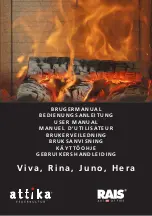
EN
W415-1467 /
C
/
08.20.18
23
7.1 OPTIMUM BURN METHOD
As soon as the door is closed, you will observe a change in the flame pattern. The flames will get smaller and
lazier because less oxygen is getting into the combustion chamber. The flames, however, are more efficient.
The flames will remain lazy but become larger again as soon as the firebricks have been heated thoroughly
and the chimney becomes heated and provides a good draft. At this point, the roaring fire that you see when
the door is opened is wastefully drawing heated room air up the chimney -- certainly not desirable. Always
operate with the door fully closed once the medium sized logs have caught fire.
You can now add larger pieces of wood and operate the appliance normally. Once the appliance is entirely
hot, it will burn very efficiently with little smoke from the chimney. There will be a bed of orange coals in the
firebox and secondary flames flickering just below the top firebrick. You can safely fill the firebox with wood
to the top of the door and will get best burns if you keep the appliance pipe temperatures between 250°F
(120°C) and 450°F (270°C). A surface thermometer will help regulate this.
Without an appliance thermometer, you are working blindly and have no idea of how the appliance is
operating! An appliance thermometer offers a guide to performance and should be located 18”(457mm)
above the flue collar. Install the thermometer according to manufacturers instructions.
Can’t get the fire going?
Use more kindling and paper. Assuming the chimney and vent are sized correctly and there is sufficient
combustion air, the lack of sufficiently dry quantities of small kindling is the problem. Thumb size is a good
gauge for small kindling diameter.
Can’t get heat out of the appliance?
One of two things may have happened. The appliance door may have been closed prematurely and the
appliance itself has not reached optimum temperature. Reopen the door and/or draft control to re-establish
a brisk fire. The other problem may have been wet wood. The typical symptom is sizzling wood and moisture
being driven from the wood.
For optimal emissions performance and efficiency follow these simple guidelines when using your appliance:
A.
Maintain a 2" (51mm) deep, hot, glowing red coal bed.
B.
Burn dry seasoned wood with less than 20% moisture content and burn so that the glass door
remains clean.
C.
A stove thermometer 18" (45.7cm) up on the single wall stove pipe should indicate 350°F (176°C) as
an average temperature.
D.
Maintain a minimal trace of smoke coming from the chimney when the appliance is burning as
intended.
E.
Inspect and replace all necessary components such as gaskets, manifolds, glass and other
components which may affect the overall appliance performance.
F.
Ensure an adequate draft to control burn rate and temperature.
Refer to “OPERATION” and “MAINTENANCE” sections for detailed information.















































